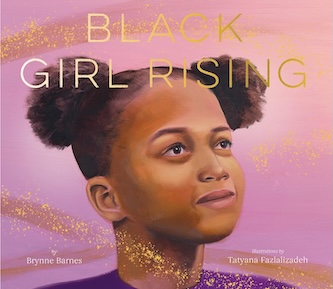Children’s Book Reviews: Celebrating Blackness
By Cyrisse Jaffee
Three engaging and spirited books celebrate Black history, culture, and resilience.
Black Girl Rising by Brynne Barnes. Illustrations by Tatyana Fazlalizadeh. Chronicle Books, 2022.
Black Boy, Rise by Brynne Barnes. Illustrations by Bryan Collier. Chronicle Books, 2025.
Juneteenth Is by Natasha Tripplett. Illustrated by Daniel J. O’Brien. Chronicle Books, 2024.
 On her website (brynnebarnes.com), the author Brynne Barnes says, “I don’t think that anyone should underestimate the importance of children being able to see themselves in the literature intended for them — to identify with characters that look like them and ones that don’t.” In Black Girl Rising, and now Black Boy, Rise, Barnes uses her own poetry, blended with references to the words of other Black writers, to create powerful statements about the oppression and liberation, trials and triumphs, and the splendid potential of young Black lives.
On her website (brynnebarnes.com), the author Brynne Barnes says, “I don’t think that anyone should underestimate the importance of children being able to see themselves in the literature intended for them — to identify with characters that look like them and ones that don’t.” In Black Girl Rising, and now Black Boy, Rise, Barnes uses her own poetry, blended with references to the words of other Black writers, to create powerful statements about the oppression and liberation, trials and triumphs, and the splendid potential of young Black lives.
In the beginning of Black Girl Rising, Barnes acknowledges the messages of sexism and racism that weigh young Black girls down: “Now don’t you dare climb, climb, climb/Langston’s crystal stair./You ain’t gonna make it, girl./Come down from there.” “You’re supposed to dim your light,” she notes, “and never be seen.”
Despite these stultifying realities, defiance and strength have also characterized Black lives: “You are a thousand curls unfurling in your hair/You are a thousand fists standing proudly in air…” The rousing text is lyrical and inspiring, effectively building on the works of Toni Morrison, Gwendolyn Brooks, Sonia Sanchez, and others. The illustrations are equally stirring, infused with lush color and showcasing a diverse range of Black faces.
The book is simple enough to use with early elementary-school kids, especially as a read-aloud, where some of its unusual words (e.g., “charisma,” “carnelian moonstone”) can be explored and explained. It could also be used in other settings: creative writing classes, African American studies, and even as a gift for grads, a la children’s books such as Oh, the Places You’ll Go!
Using a similar tone and format, Black Boy, Rise is an uplifting and exhilarating celebration of “being Black as Blackness can.” Barnes recognizes the harsh lessons that Black boys are taught about being obedient and acquiescent: “Black boy, get out of those clouds./Don’t set your sights so high…” Limited to stereotypical futures, such as sports, she writes: “Just dribble, just dunk, just pitch, just swing, just block, just tackle, just bob and weave.”
 But understanding their origins and heritage brings courage, grit, and “the power you hold inside.” Once again, the words of Black artists are intertwined with the text, from Touré to W.E.B. Du Bois to James Weldon Johnson to Lucille Clifton, exhorting boys to dream, imagine, and leap beyond society’s expectations.
But understanding their origins and heritage brings courage, grit, and “the power you hold inside.” Once again, the words of Black artists are intertwined with the text, from Touré to W.E.B. Du Bois to James Weldon Johnson to Lucille Clifton, exhorting boys to dream, imagine, and leap beyond society’s expectations.
The illustrations, by Caldecott-award winner Bryan Collier, are triumphant. Deep, rich colors evoke both urban environments and the African homeland, rendered with painterly details. This is a gorgeous companion to Black Girl Rising that also stands alone as a testament to the endurance and vitality of Black lives for all ages.
Another celebration of Black culture is told in Juneteenth Is. One could choose various dates to commemorate the end of slavery in the United States, including the Emancipation Proclamation (issued by President Lincoln on January 1, 1863) or the ratification of the Thirteenth Amendment (December 6, 1865). However, it was on June 19, 1865, that the federal government enforced the Emancipation Proclamation in Texas, the last Confederate slave state. This date, which became known as Juneteenth, was observed for more than 150 years in Black communities. Finally, in 2021, “Juneteenth National Independence Day” became a new federal holiday.
 In this appealing picture book, a little girl describes the preparation, sights, sounds, and smells of this special holiday. She notes the town’s music-filled parade, the “black, red, and green flags,” the “smoky smell” of “Daddy’s slow-cooking brisket,” and the noisy, exuberant gathering of the extended family. The cartoonish but energetic illustrations also help bring the day to life.
In this appealing picture book, a little girl describes the preparation, sights, sounds, and smells of this special holiday. She notes the town’s music-filled parade, the “black, red, and green flags,” the “smoky smell” of “Daddy’s slow-cooking brisket,” and the noisy, exuberant gathering of the extended family. The cartoonish but energetic illustrations also help bring the day to life.
On a more serious note, the narrator explains, “Juneteenth is the history lesson not taught at school…Juneteenth is remembering lives long before our memories. Sweat on our brows, cotton in our fingers, the straw that broke our mighty back.” Her Grandaddy reminds everyone that the day is not just the games played, the songs sung, or the meal made of “generations of family recipes.” It’s about “the door of opportunity no longer slamming in our faces.”
Linking the past to the present, the text clearly explains how Juneteenth came to be and why it’s important to continue to observe it, not just for Black communities, but for the entire country. This is especially resonant today, as the notion of multiculturalism, as well as Black history and culture, is in danger of being suppressed or erased. An author’s note explains the significance of the color red in the holiday selections, as well as providing a selected bibliography.
Cyrisse Jaffee is a former children’s and YA librarian and children’s book editor. She most recently created resources for the Education Department of WGBH. Cyrisse holds a master’s degree in Library Science from Simmons College and lives in Newton, MA.
Tagged: "Black Boy Rise", "Black Girl Rising", "Juneteenth Is", Brynne Barnes
